Dr. Manouchehr Moshtagh Khorasani has published a book in 2013 entitled:
Persian Archery and Swordsmanship: Historical Martial Arts of Iran
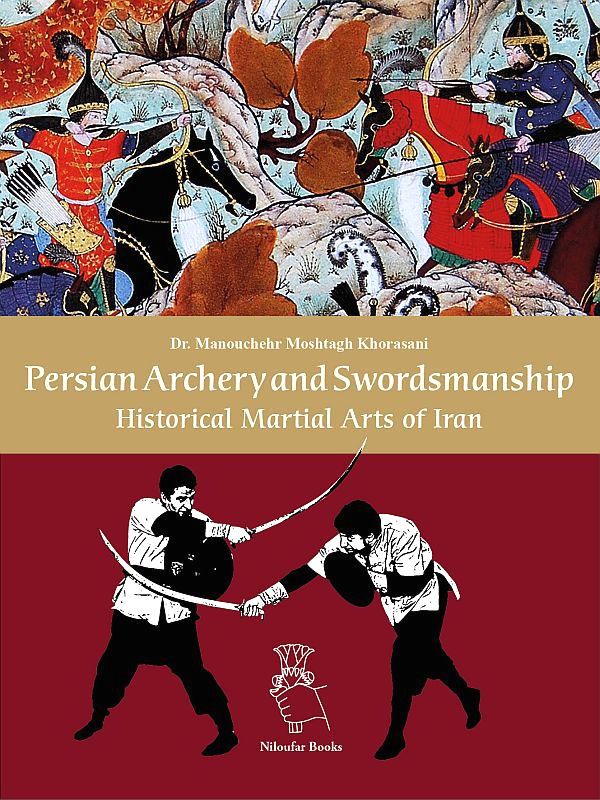
- Title: Persian Archery and Swordsmanship: Historical Martial Arts of Iran
- Author: Dr. Manouchehr Moshtagh Khorasani
- Publisher: Niloufar Books, Frankfurt am Main, Germany
- Number of pages: 392
- Date of Publication: 2013
- ISBN-13 978-3-00-039054-8
The book Persian Archery and Swordsmanship: Historical Martial Arts of Iran is a reference manual on the historical Iranian martial arts in application. The martial arts have influenced all aspects of the ten thousand year history, language and culture of the Iranian people, and remain to this day integral to the Iranian national identity as clearly demonstrated in the Persian epic the Book of Kings.
A unique martial culture has permeated all of the most important artifacts of ancient (bronze- and iron age Luristan and Marlik sites), classical (Achemenid, Parthian and Sassanids), medieval (Samanids) and early modern and modern Iran (Safavid, Afsharid, Zand and Qajar periods), in its art and archaeology, literature, physical culture and national outlook.
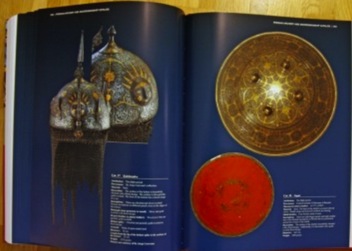
Helmets and shields (Courtesy of M. Khorasani Consulting).
It is, without doubt, a martial tradition whose lineage extends back in time to the ancient period, as evidenced by production of large numbers of copper, bronze and iron swords and other weapons made of same materials, and which subsisted in Iran through the classical period (iron and steel weapons), and culminated in the production of the magnificent crucible steel during medieval and modern periods despite all of the historical changes that Iran underwent at a political level. Accordingly, research into the martial arts of Iran has, until now, demanded an intimate familiarity with a vast range of diverse materials that deal with the subject either directly or indirectly, including direct access to rare manuscripts, manuals, arms and armor that can only be found in Iranian museums itself. With this book, that situation has now changed. The present book deals with the revival of Persian swordsmanship and the traditional martial arts of Iran. Within these pages there are no unprovenanced claims to knowledge. Everything is meticulously referenced.
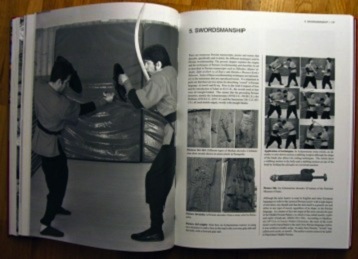
Close-quarter blade combat techniques (Courtesy of M. Khorasani Consulting).
The Iranian martial arts do not depend solely on an “oral tradition” for their lineage as well as their transmission from teacher to student, although the actual instruction is imparted from teacher to student. Rather, with regard to the lineage, every technique, every tactical advice and every method of training and application presented herein is properly provenanced with reference to at least one historical documentary source. Documentary evidence of specific techniques and training methods, taken from primary sources, fully supports every photographic and textual presentation of such techniques and methods shown in a vast number of miniatures and paintings and presented in this book. Didactic literary descriptions of martial arts, which might be likened to combat manuals, have a long history in Iran, and this book continues that tradition and showcases a number of complete and annotated manuascripts on archery, spear and lance fighting, war wrestling, etc. The Iranian martial arts presented in this book therefore hold up to a standard of academic scrutiny that will serve as a basis both for their introduction to the enthusiast or novice as well as a highly credible reference source to researchers.
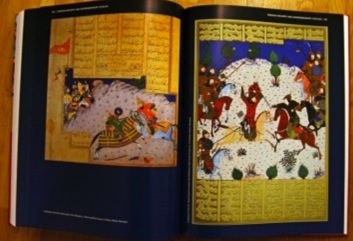
Miniature Persian arts and poetry depicting close-quarter cavalry combat (Courtesy of M. Khorasani Consulting).
The book Persian Archery and Swordsmanship: Historical Martial Arts of Iran presents in clearly tabulated descriptions, accompanied by photographic depictions as well as depictions in antique miniature illustrations, combat techniques both on horseback and on foot, and both armed with traditional Iranian weapons and unarmed. The first chapter of this book, “code of chivalry and warrior codex” deals with the warrior codex and the principles of Persian chivalry. This chapter also analyzes the training methods of the varzeš-e pahlavāni (champion sport). This traditional martial art still harbors many legacies from the training of ancient Iranian champions by, for example, using many tools that resemble historical battlefield weapons. The function of these weapons was certainly to train and prepare warriors for the upcoming battles.
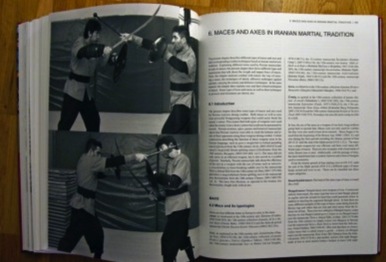
Close-quarter blade combat techniques (Courtesy of M. Khorasani Consulting).
The next chapter deals with the history, principles and techniques of archery in Iran based on different Persian manuscripts. The next part of the chapter deals with principles of archery as described in different Persian manuscripts such as the archery part in the book Nŏruznāme
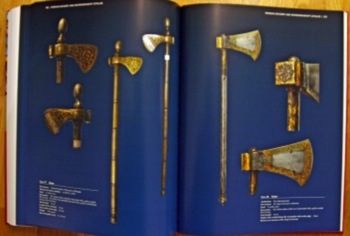
Axe-heads for close-quarter combat (Courtesy of M. Khorasani Consulting).
The next chapter discusses the techniques of swordsmanship based on a number of Persian manuscripts. Analyzing different Persian manuscripts such as epic tales and battle accounts, one notes a certain consistency in the recurrent allusion to certain techniques through the centuries. The next chapter analyzes the history of maces and axes in Iranian martial tradition.Similar to swords, the techniques of using axes and maces from various sources are analyzed and presented starting from epics from the tenth century C.E. up until relevant sources dating back to the end of the Qājār period. Another chapter provides information on combat with short edged weapons in Iran such as kārd (knife), xanjar (dagger) and pišqabz (S-shaped dagger).
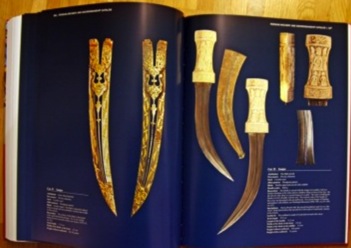
Close-quarter combat blades (Courtesy of M. Khorasani Consulting).
The following chapter informs about combat with Persian short swords named qame and qaddāre in Iranian history. Those who are interested in wrestling will find this book indispensable as a reference source, as wrestling, of various types, has an extremely long history in Iran and is perhaps the most important foundation in the training of the Persian warrior archetype. Wrestling is highly systematized and there are prescribed criteria for graduation through various ranks of a wrestling school as well as detailed descriptions of wrestling techniques and sets of counters to every wrestling technique. Wrestling itself is also the basis of many techniques that are to be executed when armed with traditional weapons both long and short, as one of the most important objectives in Iranian martial arts is to take the opponent to the ground to finish him off (often with a dagger), and another is to use wrestling techniques in conjunction with a sword, or with a sword and shield in preparation to administer a finishing stroke.
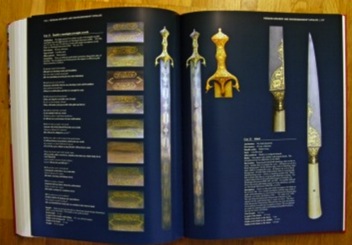
Swords and blades of the straight type (Courtesy of M. Khorasani Consulting).
The wrestling chapter deals with wrestling which was an integral part of combat in Iran and includes the following sections: wrestling in Iranian history, techniques of wrestling on the battlefield (dealing with grabbing the sword hand or weapon hand of the opponent and throwing the opponent and using wrestling techniques on the battlefield).The chapter also offers the complete translated and annotated wrestling manuscripts. One of them is a wrestling manuscript written by Šarif Mohammad the son of Ahmad Mehdi Hosseyni from the period of Šāh Esmā’il Safavid. The chapter also offers a complete translated and annotated manuscript of the Tumār-e Puryā-ye Vali (Scroll of Puryā-ye Vali). The Safavid-period manuscript offers the names of many wrestling techniques. The chapter also presents a complete translated and annotated version of the Qājār-period poem Masnavi-ye Golkošti-ye Mirnejāt that deals with the topic of wrestling. The poem mentions a wide array of wrestling techniques.
The book Persian Archery and Swordsmanship: Historical Martial Arts of Iran also offers a fully colored catalog of a number of historical Persian arms and armor at the end of the book with detailed descriptions and measurements. Additionally the book has many miniatures depicting different war scenes from a number of Persian manuscripts.
TABLE OF CONTENTS
1. CODE OF CHIVALRY AND WARRIOR CODEX
1.1 Warrior behavior, ceremony and respect
1.2 The principles of javānmardi and ayyārān
1.3 Preparation and training of warriors
1.4 Physical exercises and training tools in the zurxāne
1.5 Conclusion
2. THE SACRED WEAPON: ARCHERY IN IRAN
2.1 Archery in Iranian history
2.2 Composite bow
2.3 Bow and its typologies
2.4 Arrow
2.5 Thumb protector
2.6 Bowstring
2.7 The quiver and the bow case
2.8 Arrow guide
2.9 Principles of archery
2.10 Target areas for archery
2.11 Persian manuscripts on archery
2.12 Conclusion
3. MOUNTED COMBAT AND HORSE CLASSIFICATION IN PERSIAN MANUSCRIPTS
3.1 Fighting with the lance on horseback
3.2 Fighting with the mace and axe on horseback
3.3 Sword drawing and swordfighting on horseback
3.4 Grabbing, grappling and wrestling techniques on horseback
3.5 Techniques and weapons for attacking a horse or an elephant
3.6 A manuscript on lance combat by Šarif Mohammad the son of Ahmad
Mehdi Hosseyni from the period of Šāh Esmā’il Safavid.
3.7 Using lasso on horseback
3.8 Horse classification in Persian manuscripts
4. COMBAT WITH SPEARS AND LANCES IN IRANIAN HISTORY
4.1 Spears and lances in Iranian history
4.2 Spear/lance and its typologies
4.3 Attack techniques with a lance/spear
4.4 Feinting techniques with a lance/spear
4.5 Defense techniques with a spear/lance
4.6 Combinations of lance/spear techniques
4.7 A manuscript on spear combat by Šarif Mohammad the son of Ahmad
Mehdi Hosseyni from the period of Šāh Esmā’il Safavid
4.8 Spear in combination with the shield
4.9 Conclusion
5. SWORDSMANSHIP
5.1 Carrying, sheathing, and unsheathing the sword
5.2 Carrying the shield
5.3 Attacking techniques
5.4 Feinting Techniques
5.5 Combinations
5.6 Defensive techniques
5.7 Possible combinations of the attack and defense techniques with a šamšir
(sword) and a separ (shield) in Persian swordsmanship
5.8 A manuscript on swords by Šarif Mohammad the son of Ahmad Mehdi
Hosseyni from the period of Šāh Esmā’il Safavid (1502-1524 C.E.)
5.9 Conclusion
6. MACES AND AXES IN IRANIAN MARTIAL TRADITION
6.1 Maces in Iranian history
6.2 Mace and its typologies
6.3 Weight and impact force of the mace
6.4 Carrying the mace
6.5 Techniques of mace attacks
6.6 Defensive techniques with a mace
6.7 Combinations of fighting techniques with the mace
6.8 General aspects about the axe
6.9 Techniques of attack with an axe
6.10 Combinations with an axe
6.11 Conclusion
7. COMBAT WITH SHORT EDGED WEAPONS IN IRAN
7.1 Definition of kārd (knife)
7.2 Kārd in Persian manuscripts
7.3 Carrying and unsheathing a knife
7.4 Techniques of attack using a knife
7.5 Combination of techniques in fighting with a knife
7.6 Definition of xanjar
7.7 Xanjar in Persian manuscripts
7.8 Carrying and unsheathing the dagger
7.9 Techniques of attack with a dagger
7.10 Combinations of fighting techniques with the dagger
7.11 Definition of pišqabz
7.12 Conclusion
8. THE COMBAT WITH SHORT SWORDS: QAME AND QADDĀRE
8.1 Attack techniques with a qaddāre
8.2 Possible combinations with a qaddāre
8.3 Attack techniques with a qame
9. WRESTLING: AN INTEGRAL PART OF COMBAT IN IRAN
9.1 Wrestling in Iranian history
9.2 Techniques of wrestling on the battlefield
9.3 Wrestling manuscript by Šarif Mohammad the son of Ahmad Mehdi Hosseyni from the period of Šāh Esmā’il Safavid
9.4 A comparative analysis of the techniques mentioned in the Safavid period wrestling manuscript
9.5 The manuscript of the Tumār-e Puryā-ye Vali (Scroll of Puryā-ye Vali)
9.6 A comparative analysis of the techniques mentioned in the manuscript Tumār-e Puryā-ye Vali
9.7 The manuscript Masnavi-ye Golkošti-ye Mirnejāt
9.8 A comparative analysis of the techniques mentioned in the Mirnejāt manuscript
9.9 Conclusion
10. References
12. Catalog
Some facts and statistics on the book Persian Archery and Swordsmanship: Historical Martial Arts of Iran
Number of pages: 392 pages
Endnotes: 2189
Weight of the book: 2400 grams
Size: 30,5 cm x 22,5 cm
Total number of pictures: 2095
1) Pictures of techniques: 1564 total
64 pictures of dagger techniques
64 pictures of knife techniques
145 pictures of qame and qaddare techniques
232 pictures of spear techniques
322 pictures of sword and shield, two swords, two handed sword techniques
149 pctures mace and axe techniques
460 pictures of wrestling techniques
128 pictures of varzesh- pahlavani techniques
2) Miniatures: 313 total
303 miniatures within the text
Full-page colored miniatures in th catalog: 10
3) Artifacts 218 total
Number of artifacts in the catalog: 40
Full-colored pictures of artifacts in the catalog: 178



